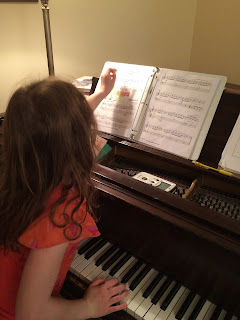It's that time of year when I'm preparing my students for our big Spring solo recital. This is the biggest recital of the year for my students and a lot of preparation goes into getting ready. I was excited to see an idea from an amazing piano teacher, Karen Hunter, who gave me a lot of great ideas for my violin students as well and I've asked her to write today's post:
The
week my students choose their spring recital pieces is (by my students’ own
admission) a highlight in my piano studio.
I teach 70 students in three teaching venues, so I begin the music
“vetting” process in the summer. Two of my
three recitals have themes, so the selection process is slightly easier for
those recitals. Students spend much of
their first lesson of the new year listening to me play recital piece options
and, ultimately, they select one.
The
Saturday morning before lessons resumed in 2016, I spent some time perusing
piano teaching ideas on Pinterest.
Something I read triggered the thought that if students are to spend 12 l-o-n-g weeks working on a single song
to perform at the spring recital, perhaps it would be beneficial to have the
students get familiar with the song and its composer before learning to play
it.
That
thought morphed into the creation of the “Recital Piece Hunt” worksheet which
students were to complete for the second lesson of the new year. Reviewing students’ responses with them
provided many teachable moments. For
example:
- Younger students discovered that songs have a “form”—a kind of map of a piece.
- Many students were reminded that a song without sharps or flats may not necessarily be in the Key of C Major. This resulted in a review of relative major and minor scales.
- Students became acquainted with the various “articulations” used in their pieces. What exactly is tenuto?
- Students googled “rubato” and other unfamiliar performance instructions.
- We discussed metronome markings and googled the definition of circa (as in ♪=ca.60).
- Younger students were skeptical that a quarter note could receive two beats (in 3/8 or 6/8 time).
- One student couldn’t wait to tell me that her composer (Robert Vandall) had a wife whose name was Karen! Same as you, Mrs. Hunter!
As my students
proceed with learning their pieces, I’m confident that they have adequate
background into their pieces and their composers.
To provide
students with a “visual” of their progress in learning their pieces, I created “Scoops
to a Great Performance” contest cards.
As students move from hands apart to hands together, from slow to
performance tempo, to adding pedal and dynamics, I mark another scoop on their
7-scoop cone. When the piece is
performance-ready and (hopefully) memorized, the student receives a token for a
free scoop of custard from our local custard stand. Prepping a piece for performance is a
step-by-step process. I hope this contest
encourages my students every step of the way!
Download Here















